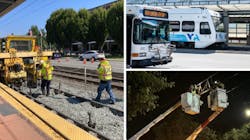Santa Clara VTA making progress on light-rail system upgrades
Since April of this year, the Santa Clara Valley Transportation Authority (VTA) has issued multiple shutdowns on its light-rail system to complete upgrades to the nearly four-decade old system. The agency says the multiple shutdowns focused on repairing and replacing items on the light-rail tracks and segments where equipment was approaching the end of its useful life.
The work was divided into two major ongoing construction efforts that happened simultaneously this year: rail rehabilitation and the overhead catenary system rehabilitation.
Rail rehabilitation
The agency notes rail rehabilitation construction involves the replacement on the system’s trackway. Concurrently, the work windows allow for making improvements to the system. During this year’s planned work, the Santa Clara VTA team was able to accomplish the following:
- Installation of new crossover at Champion light-rail station, which is a priority for Super Bowl 60 and FIFA 2026 events to support special event train service.
- Ballast and tie replacement at 12 light-rail stations, which totals more than 2,000 wood crossties replaced and 2,000 tons of new ballast.
- Grade crossing replacement at Lawrence Expressway.
- Track realignment between Tamien and Curtner light-rail stations (approximately one mile).
- Chynoweth track junction replaced, approximately 2,500 feet.
- Overhead catenary system foundations for new Bonaventura crossover.
Overhead catenary system rehabilitation
The Overhead Catenary System Rehabilitation construction involved replacement of overhead light-rail power cables and structural components. During this year’s planned efforts, the Santa Clara VTA team was able to accomplish the following:
- 200,000 feet, which equals 37 miles of contact wire replacement and associated structural components
- 67 disconnect switch replacements
Santa Clara VTA notes while construction activities took place, light-rail service at the impacted stations was temporarily replaced by a bus bridge or temporary bus service. Since the first shutdown, bus operators completed more than 8,000 service hours dedicated to providing bus bridges to ensure riders could still travel to their destinations.




